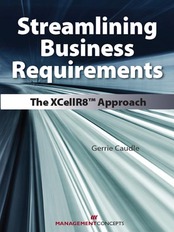Streamlining Business Requirements
The XCellR8 Approach
Gerrie Caudle (Author)
Publication date: 07/01/2009
Effectively Define and Gather Your Business Requirements Today!
Many programming systems today are designed and constructed before business requirements are completed and finalized. Without a proper foundation, these systems will eventually crumble. Streamlining Business Requirements: The XCellR8™ Approach provides project managers and business analysts with the foundation, principles, and steps needed to document business requirements in an accurate and efficient manner. Author Gerrie Caudle introduces the XCellR8™ approach, an analysis method used to gather business requirements in a structured, well-defined set of steps.
This book offers comprehensive framework needed to:
• Effectively analyze business requirements
• Properly identify business events
• Prepare for a requirements session
• Better understand the “big picture”
Many programming systems today are designed and constructed before business requirements are completed and finalized. Without a proper foundation, these systems will eventually crumble. Streamlining Business Requirements: The XCellR8™ Approach provides project managers and business analysts with the foundation, principles, and steps needed to document business requirements in an accurate and efficient manner. Author Gerrie Caudle introduces the XCellR8™ approach, an analysis method used to gather business requirements in a structured, well-defined set of steps.
This book offers comprehensive framework needed to:
• Effectively analyze business requirements
• Properly identify business events
• Prepare for a requirements session
• Better understand the “big picture”
Formats
Paperback - $57.95 - Members: $52.16
Paperback - $57.95 - Members: $52.16
ePub - $57.95 - Members: $40.57
PDF eBook - $57.95 - Members: $40.57
Find out more about our Bulk Buyer Program
- 10-49: 20% discount
- 50-99: 35% discount
- 100-999: 38% discount
- 1000-1999: 40% discount
- 2000+ Contact ( bookorders@bkpub.com )
Orders of 10+ copies shipping to one address receive free ground shipping
within the U.S. Shipping to separate individual addresses via USPS media mail will be applied a handling fee:
Book Details
Overview
Effectively Define and Gather Your Business Requirements Today!
Many programming systems today are designed and constructed before business requirements are completed and finalized. Without a proper foundation, these systems will eventually crumble. Streamlining Business Requirements: The XCellR8™ Approach provides project managers and business analysts with the foundation, principles, and steps needed to document business requirements in an accurate and efficient manner. Author Gerrie Caudle introduces the XCellR8™ approach, an analysis method used to gather business requirements in a structured, well-defined set of steps.
This book offers comprehensive framework needed to:
• Effectively analyze business requirements
• Properly identify business events
• Prepare for a requirements session
• Better understand the “big picture”
Many programming systems today are designed and constructed before business requirements are completed and finalized. Without a proper foundation, these systems will eventually crumble. Streamlining Business Requirements: The XCellR8™ Approach provides project managers and business analysts with the foundation, principles, and steps needed to document business requirements in an accurate and efficient manner. Author Gerrie Caudle introduces the XCellR8™ approach, an analysis method used to gather business requirements in a structured, well-defined set of steps.
This book offers comprehensive framework needed to:
• Effectively analyze business requirements
• Properly identify business events
• Prepare for a requirements session
• Better understand the “big picture”
About the Author
Excerpt









